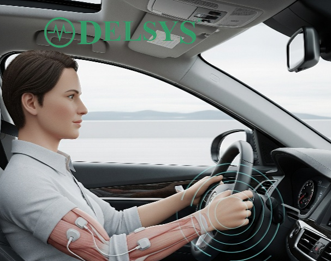Introduction
Tobii eye-tracking metrics such as fixation, saccade, pupil dilation, blink rate, and PERCLOS are critical components in the development of Driver Monitoring Systems (DMS) and Advanced Driver Assistance Systems (ADAS). Each of these measures provides valuable insights into driver state, from attention and distraction to fatigue and cognitive load. By integrating these metrics into ADAS, systems can enhance driver safety, assist in real-time risk assessment, and adapt to various driving conditions. The combination of eye-tracking data with machine learning techniques holds promise for the next generation of intelligent and adaptive driver assistance systems.
Table of Contents
- Use of Fixation Data in DMS and ADAS
- Use of Saccade Data in DMS and ADAS
- Soma Reality Solutions for Pupil Dilation
- Blink Rate and its Use in DMS and ADAS
- PERCLOS (Percentage of Eye Closure) in DMS and ADAS
- Frequently Asked Questions
1. Use of Fixation Data in DMS and ADAS (Eye Fixation Duration and Location using “Tobii Eye Tracker Glasses 3”)
- Driver Focus and Attention
- Predicting Driver Fatigue: indicative of driver drowsiness or fatigue.
- Research Example: A study by Vera et al. (2018) used fixation data to monitor driver attention levels in real time, noting that increased fixations on secondary tasks (e.g., adjusting controls) correlated with increased accident risk. They emphasized the potential of eye-tracking as a real-time indicator of driver attention, which can be fed into DMS to warn drivers about potential distractions (Vera et al., 2018).
2. Use of Saccade Data in DMS and ADAS (Eye Movement and Speed using “Tobii Eye Tracker Glasses 3”)
- Visual Search Efficiency and hazard detection.
- Predictive Models of Driver Behavior: for fatigue or cognitive impairment. An early warning system could alert the driver or trigger a safety intervention by ADAS (Herman et al., 2016).
- Research Example: In Guerreiro et al. (2017), saccade velocity was used to analyze the reaction time of drivers in simulated driving tasks. They found that slower saccadic movements correlated with a higher likelihood of delayed responses to stimuli, which can be integrated into ADAS for hazard prediction.
3. Soma Reality Solutions for Pupil Dilation (Pupil Size and Cognitive Load)
Data Source: “Tobii Eye Tracker Glasses 3”
- The pupil reacts to both light and cognitive load. Increased pupil dilation is typically linked to increased cognitive workload, stress, or engagement with a task.
- Stress and Cognitive Load Detection: to adjust driving assistance features, such as providing more guidance or reducing complexity in interface displays (Bradley et al., 2008).
- Fatigue Detection: can indicate the onset of fatigue or drowsiness. This is critical for a DMS to alert the driver to take a break (Hirata et al., 2014).
- Research Example: Bradley et al. (2008) found that pupil dilation was highly correlated with the workload imposed on drivers during different road tasks, such as navigation or complex driving scenarios. Monitoring pupil size allows ADAS to adapt the vehicle’s driving assistance depending on the detected mental workload.
4. Blink Rate (Frequency of Blinks using “Tobii Eye Tracker Fusion 250 Hz”) and its Use in DMS and ADAS
- A higher blink rate can suggest fatigue or distraction, while a lower rate can indicate drowsiness or intense concentration.
- Fatigue and Drowsiness Detection: associated with driver fatigue (Caldwell & Caldwell, 2005). In ADAS, this data can trigger warnings when drowsiness is detected.
- Distraction Detection: indicative of a driver’s hyper focus on a task or object, possibly indicating a cognitive overload or high distraction level (Hirata et al., 2014).
- Research Example: A study by Hirata et al. (2014) utilized blink rate data to detect drowsy driving behavior. They proposed that combining blink rate and pupil dilation data can provide a more accurate real-time fatigue detection system for DMS.
5. PERCLOS (Percentage of Eye Closure) and its Use in DMS and ADAS
- Drowsiness and Alertness Monitoring: indicators of fatigue, as increased eye closure suggests that the driver is nearing the point of sleep. Monitoring PERCLOS is effective for real-time fatigue detection, allowing DMS systems to issue alerts or even trigger autonomous driving support in extreme cases (Van Dongen et al., 2004).
Conclusion
By leveraging fixation, saccade, pupil dilation, blink rate, and PERCLOS data, DMS and ADAS can deliver powerful, real-time insights into driver behavior. These metrics, when combined with advanced analytics and machine learning, offer a promising pathway toward safer and more adaptive driving environments.
Frequently Asked Questions (FAQ)
1. What is DMS ?
A driver management system (DMS) is a technological solution designed to optimize the performance, safety, and compliance of drivers within a fleet-based business. It goes beyond basic vehicle tracking, focusing on the human element of fleet operations and empowering businesses to manage their drivers efficiently and proactively.
2. What is ADAS ?
Advanced Driver-Assistance Systems (ADAS) are a collection of technologies in modern vehicles designed to enhance driver safety, comfort, and efficiency. They leverage sensors, cameras, radar, and advanced software to monitor the vehicle’s surroundings and assist drivers in various aspects of driving and parking.
3. What is fixation data in driver monitoring systems?
Fixation data refers to the duration and location of a driver’s gaze on specific points in their environment. Using tools like Tobii Eye Tracker Glasses 3, fixation patterns can help determine driver focus and detect signs of fatigue or distraction.
4. How is saccade data used in ADAS?
Saccade data measures rapid eye movements between fixation points, along with their speed. In ADAS, slower saccadic movements can indicate delayed reaction times, which may signal fatigue or cognitive impairment.
5. Why is pupil dilation important for driver safety?
Pupil dilation reflects both light conditions and cognitive load. Increased dilation can indicate stress, mental workload, or fatigue, enabling DMS and ADAS to adjust assistance features or alert the driver.
If you’d like to dive deeper into any particular study or point, feel free to ask us at parag@tidentech.com or tidentech@gmail.com or call us on +91 9987442274.







